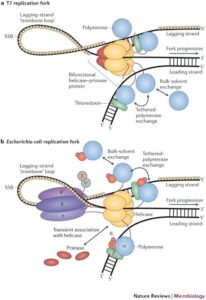Back to: MICROBIOLOGY 100 LEVEL
Welcome to class!
My smart friend, welcome again! It’s always a joy to see you here, learning and growing stronger every day. Today, we’re going to learn about something really special—Replication, Transcription, and Translation in Prokaryotes. These big words might sound complex at first, but don’t worry. I’ll walk you through it step-by-step like we’re baking meat pie from scratch together—calm, easy, and one ingredient at a time!
Replication, Transcription, And Translation In Prokaryotes
Replication in Prokaryotes
Replication simply means copying DNA. Before a bacterial cell divides, it must first copy its DNA so that each new cell will have the exact same information—just like how you’d photocopy your JAMB form so both your mum and dad can have a copy.
In prokaryotes like bacteria:
Replication starts at a single point called the origin of replication.

Enzymes like DNA helicase unzip the DNA, and DNA polymerase adds new matching bases.
The result is two identical copies of the DNA, each for one daughter cell.
It’s fast and efficient because bacteria need to grow and multiply quickly—some can divide every 20 minutes!
Transcription in Prokaryotes
After copying the DNA, the next step is transcription—converting DNA instructions into RNA.
Here’s how it works:
The enzyme RNA polymerase reads the DNA and builds a strand of messenger RNA (mRNA).
The mRNA is like a small note that carries instructions from the DNA out to the part of the cell that makes proteins.
It’s like writing out your grandma’s soup recipe from her big, old notebook (DNA) onto a small paper (mRNA) you can carry to the market.
Translation in Prokaryotes
Now it’s time for translation—this is where the mRNA message is turned into a protein.
In the cytoplasm:
Ribosomes read the mRNA in sets of three bases called codons.
Each codon tells the ribosome which amino acid to add.
Transfer RNA (tRNA) brings the right amino acids to build the protein chain.
The final product is a protein, which may be an enzyme, a toxin, or part of the bacterial cell wall.

It’s like using the shopping list (mRNA) to gather ingredients (amino acids) and prepare a delicious meal (protein)!
Let’s imagine a tailor’s shop:
Replication is photocopying the agbada pattern so more tailors can use it.
Transcription is writing the instructions for how to sew it.
Translation is the tailor using the instructions to sew the actual agbada.
Summary
- Replication is when DNA is copied before cell division.
- Transcription is when DNA is used to make mRNA.
- Translation is when mRNA is used to make proteins.
- These processes work together to ensure the cell functions properly.
- In prokaryotes, all of this happens quickly and in the same space (the cytoplasm), unlike in human cells.
Evaluation
- What is DNA replication?
- What enzyme is responsible for making mRNA from DNA?
- What is the role of tRNA in translation?
- Explain why replication is important before a cell divides.
- Describe transcription and translation using an everyday example.
This lesson shows how life happens at the tiniest levels. By understanding these steps, you’re getting closer to thinking like a real scientist. Keep shining, keep learning, and remember—Afrilearn believes in your greatness. Let’s keep going strong!
